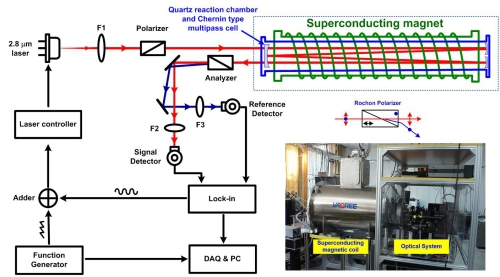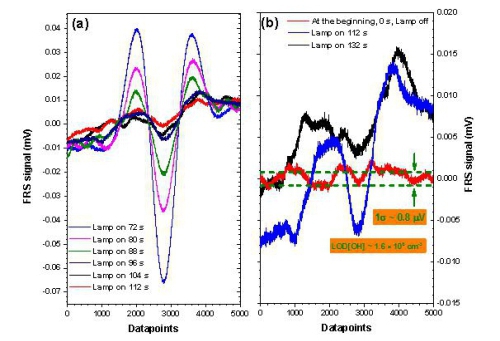[Chinese instrument network instrument research and development] Recently, the Chinese Academy of Sciences Anhui Hefei material researcher Anhui Institute of Optics and Fine Mechanics Research Zhang Wei Group, strong magnetic field science researcher Chen Wenge team and Wanrui Cold Power Technology Co., Ltd. cooperation established internationally The first OH radical device based on magnetic rotation absorption spectroscopy of superconducting magnets realizes real-time in-situ measurement of 106 moles/cm3 of OH radicals.

Figure 1. Schematic and photograph of an OH free radical device based on magnetic rotation absorption spectroscopy of superconducting magnets

Figure 2. Changes in OH radical FRS signal during ozone photolysis experiments. (a) FRS signal at different times of reaction; (b) FRS signal near the end of the reaction.
The OH radical is an important oxidant in the atmosphere, and almost all oxidizable trace gases in the troposphere are converted and removed mainly by reacting with OH radicals. Therefore, the concentration of OH radicals in the atmosphere can be used as an indicator of atmospheric oxidizing ability, and its sources and sinks and reaction processes are closely related to regional and global climate changes, atmospheric ozone levels, and acid deposition and other major environmental issues. However, OH radicals have high reactivity, short life span, and low concentration, and their accurate measurement is very difficult. It is a challenging research topic in the field of atmospheric chemistry.
Magnetic Rotary Absorption Spectroscopy (FRS) utilizes the Faraday effect of paramagnetic molecules in a longitudinal magnetic field to cause Zeeman splitting at the molecular energy level. Magnetic rotation absorption spectra are obtained by modulating and demodulating the optical rotation signal. The method can significantly enhance the signal of paramagnetic molecules, and at the same time can eliminate the interference of other anti-magnetic molecules such as water and volatile organic components commonly found in the atmosphere, and has high detection sensitivity.
Previously, Zhao Weixiong, a researcher at the Anhui Institute of Optomechanics, took the lead in the development of a new OH radical detection method based on mid-infrared 2.8-micrometer magnetic rotational absorption spectroscopy. In the recent research, researchers for the first time applied the large-diameter conductive cooling superconducting magnet system to the magnetic rotation absorption spectrum, and combined it with the atmospheric photochemical reaction smog chamber experiment system, and achieved a light absorption distance of 108 meters. The detection limit of OH radical 1.6×106/cm3, the measurement accuracy is better than 3%. The successful development of this instrument will provide a research platform for the study of OH radical-related atmospheric chemical processes, promote the in-depth study of the atmospheric chemistry core issues such as the new mechanism of regeneration of OH radicals, atmospheric oxidation, VOC degradation mechanism, and aging of organic aerosols. It is of great significance to study the current atmospheric composite pollution in China.
The study was supported by the National Natural Science Foundation of China, the Youth Innovation Promotion Association of the Chinese Academy of Sciences, and the Anhui Outstanding Youth Fund.
(Original title: Hefei Research Institute made progress in OH radical detection research)